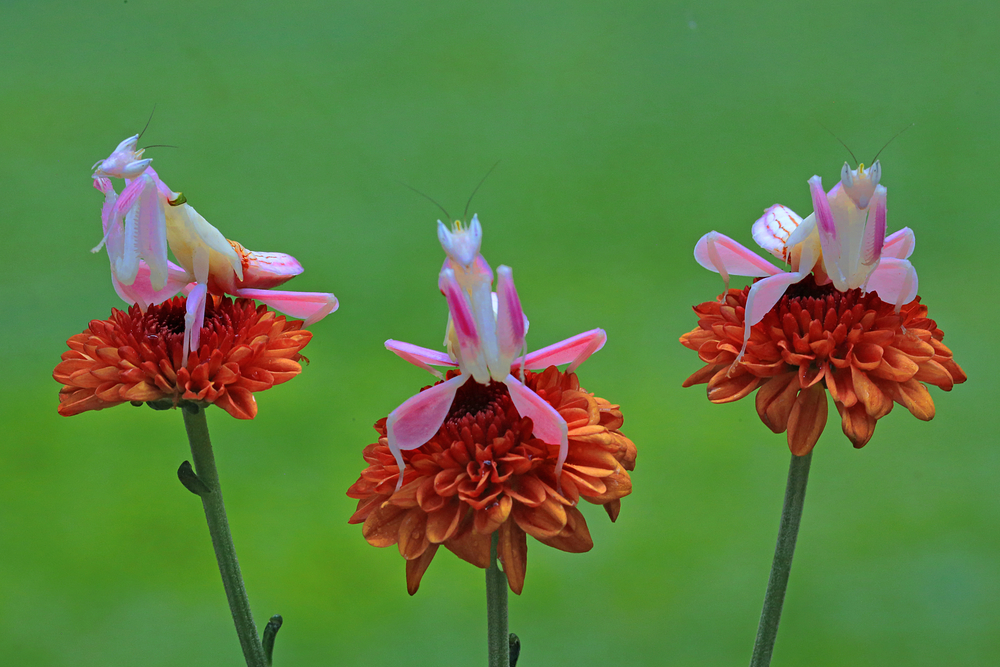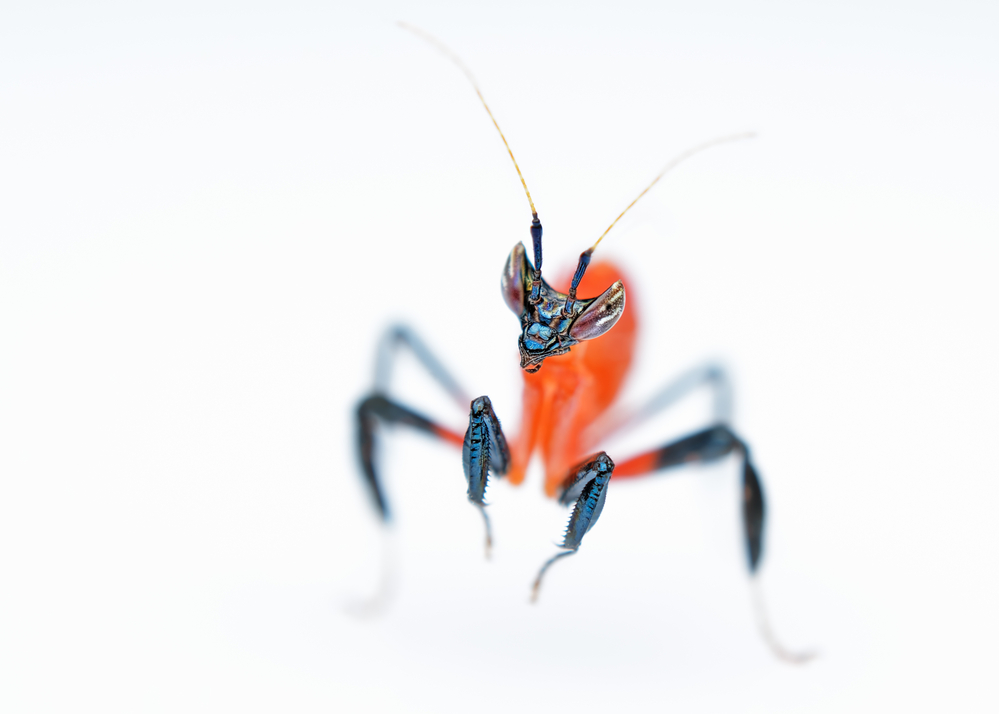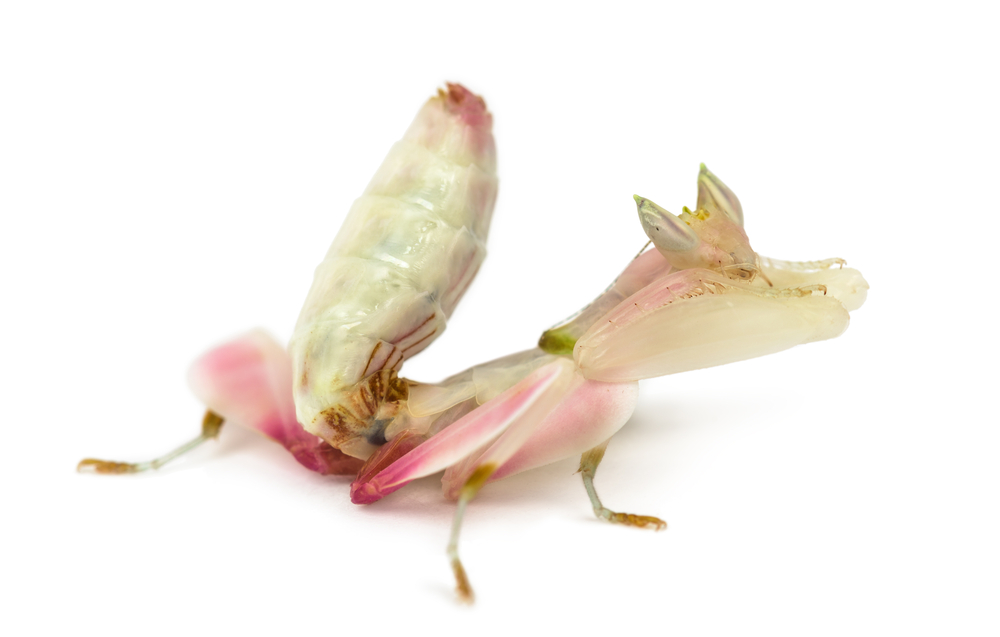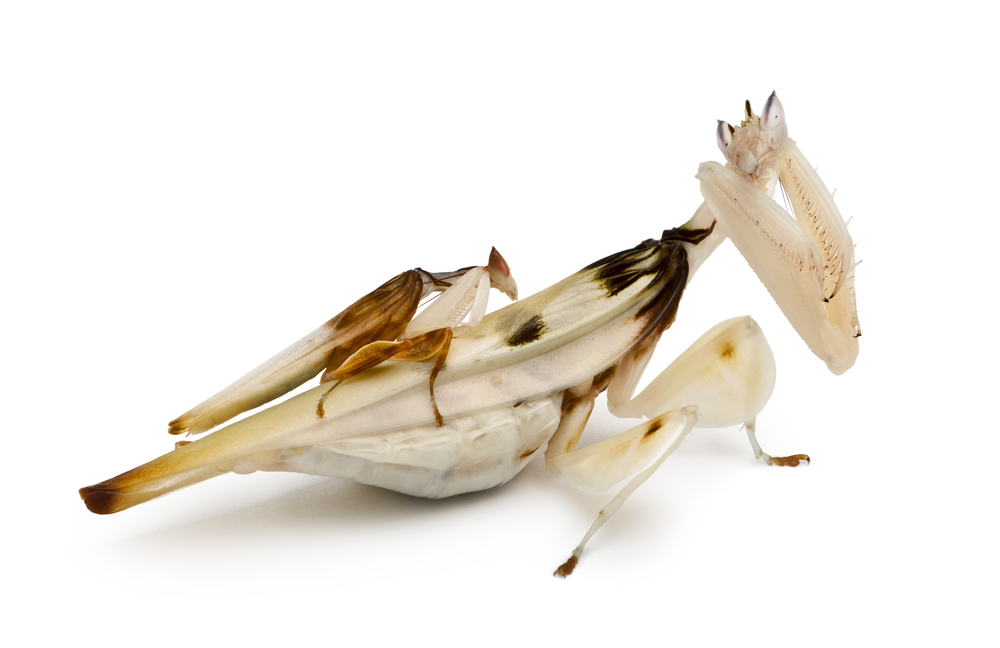Orchid mantis, also known as the walking flower or the kung fu mantis, are one of the most elegant insects that can be owned as pets. Native to tropical forests in Southeast Asia they have mastered the art of blending in to catch their prey and hide from their predators.
- Species: Hymenopus coronatus
- Diet: Small flying insects
- Hydration: Misting or water droplets
- Habitat: Solid sided with ventilation or fully mesh
- Personality: Females are quiet and calm, Males are hyperactive and skittish
- Lifespan: 5 – 8 months
- Size: Females are 6 – 7 cm long, Males are about 2.5 cm
- Care Level: Beginner – intermediate
- Compatibility: House individually
What is an Orchid Mantis?

Orchid mantis are members of the flower mantis family, named for their ability to blend in with flowers. They often have bright colors as well as “lobes” which are fin-like protrusions on their legs to mimic flower petals in a survival tactic called aggressive mimicry.
They have a semi-translucent, white, body with colored accents that can be pink, yellow, orange, green, or brown. They have very long slender limbs. Some of them also have a dark spot on their abdomen that can appear like a flower bud. Over the span of several days, your mantis can shift colors depending on their environment.
It has also been found that under UV light they are nearly indistinguishable from flowers, making them much harder for bees to tell the difference between the two, which makes for an easy catch for a meal for the mantis.
Males and females can easily be distinguished. Males are much smaller than the females. On average the males are only 2.5 cm long while the females can be up to 7 cm long! Females also have 6 body segments vs the males 8. One interesting way to also be able to tell them apart is that they have what’s called a necklace. The necklace is a marking that shows up after their 3rd molt (L4). It is on the back of their necks, for males it is a brown-red color and the females typically have a green one.
Females rely on their more elaborate lobes to stay on bushes, mimicking a flower enough to attract bees and other prey while also blending in enough to avoid being eaten by predators. The males use their smaller size and less outlandish body size to be able to fly and jump to catch their prey.
Life Cycle of an Orchid Mantis
Mantes have three major life stages: egg, nymph, and adult.
The average lifespan for orchid mantis depends on their sex. Due to the males’ extremely small size, they mature at a much quicker rate, leaving their lifespan only around 6 months. Females on the other hand have the upper hand having a lifespan of 8 months.
Mantes age is referred to using “Lx”. When they hatch they are labeled as L1 and every time they molt that number goes up.
The Egg Stage
Mantis eggs are called an ootheca. When laid it has a white foamy case around it that hardens after a few days. For an orchid mantis, it can contain upwards of over 100 eggs. It takes them 6 weeks to hatch. In nature, they are laid at the beginning of winter and they hatch in early spring.

The Nymph Stage
Upon hatching they are referred to as nymphs. Nymphs often consume their siblings upon hatching to try and get a head start on growing. These nymphs will go through 7 molts to reach adulthood. During the first 10 days of their life, they will go through their first molt, moving up to L2. By L2 they can be sexed accurately.

Once they hit L3 they must be separated to prevent cannibalism. They should be separated sooner if there is any aggression towards each other or guarding over food.
At L7 it will be considered their “sub-adult stage”, being their stage right before their final molt to enter adulthood. You will see the beginning steps of maturity here with the development of their wing buds.
With orchid mantis their maturity rate depends on their temperature, this will be covered in the housing requirements section.
The Adult Stage
2 to 3 weeks after their final molt they will be at the ideal maturity to mate. Males typically only live to be 5 to 6 months old while females live closer to 9 months old. Once the ootheca is laid the female dies shortly after.
Housing Requirements
There are two main types of enclosure they can be kept in: solid-sided with ventilation or fully mesh. Because of the humidity requirement of this species, the solid sides are recommended for easier upkeep. They should be housed separately to prevent cannibalistic behavior.
Sizing
For the mantis to have enough room the enclosure needs to be, at minimum, three times the height as the mantes length, three times longer than the mantes length, and twice as wide as the mantes length. For an average size female, you will be looking at a minimum of a 24 cm tall x 16 cm wide x 24 cm long enclosure. Orchid mantis rely on blending in on plants in nature so they should be provided with lots of artificial plants, flowers, and perches.
Due to their much more delicate exoskeleton, they have one of the most difficult molts of all mantis. This means that they require more room to molt successfully which needs to be taken into consideration when looking at enclosure sizing.
Nymphs should be kept in a smaller than minimum enclosure so they can catch their food easier and don’t get lost within their enclosure.

Type of Enclosure
Two types of enclosures can be used for mantis. The first one is having solid sides, typically made of glass or plastic. This enclosure needs to have ventilation added to it through the use of a screen or mesh material. Solid side enclosures don’t have to be a tank, a jar can even be used as long as it has the proper ventilation. The second type is having a fully mesh enclosure such as one used for butterflies.
For orchid mantis, there is a fine line between too little ventilation (causing mold outbreaks and stagnant humidity) and too much ventilation (making it much harder to keep them at their required humidity). Solid side enclosures need to have a minimum of 20% be ventilation through mesh or holes.
As the temperature is increased, so should the amount of ventilation. At least a minimum of 20% should be ventilation, but due to the high temperature and humidity these mantes need to be kept at they will most likely need more than that.
Hatchling orchids are incredibly tiny, making them highly susceptible to escaping through the large mesh or ventilation holes. Many people will raise them in a fully, fine-meshed enclosure with a zipper, this allows for high ventilation (the nymphs are more sensitive to high humidity) while keeping them in.
Temps and Humidity
They need to be kept at a temperature between 77 and 95 degrees Fahrenheit during the day and a minimum of 65 degrees at night. Under the cage heat mats can be used to provide a low level of heat, ceramic heat emitter bulbs can also be used (these produce no light) or low-level basking bulbs (these produce light).
The ideal humidity range is 60-80% for adults. They need to be misted regularly to keep it at the right level. A humidity gauge can be bought from most hardware stores or pet stores. They can be misted upwards of twice per day if needed or as little as once per week. ( *NOTE* City-based tap water is not safe for mantes due to the chemicals in it, well water can be used safely. Spring water (with no added fluoride or other additives), Reverse Osmosis (RO) water, and distilled water can all also be used safely)
It’s essential to have proper ventilation to prevent mold outbreaks with these high levels of humidity.
Nymphs need to be kept at a lower humidity than the adults as they are more sensitive to it. Humidity can be raised when they are close to molting to help prevent them from getting stuck.
Males need to be kept at a lower temperature while growing if you are looking at breeding them. Keeping them between 59 and 65 degrees Fahrenheit will stunt their growth rate enough to match them with the growth rate of the female.
If Mold is Found
If mold is found the mantis need to be moved out immediately to prevent them from getting sick.
A mild dish soap or soaking with a vinegar/water solution is the best to clean the decorations. They need to be fully rinsed and dry before they are returned to the enclosure.
The substrate needs to be changed when mold is found. The substrate should be changed at least once a week with the high humidity in the orchid environment. To reduce the mold frequency you can reduce the amount you are misting the enclosure (as long as it’s high enough humidity) or add more ventilation.
Details and Decorations
One of the most important parts of an enclosure is the substrate. Paper towels are great for a temporary enclosure, especially if you are raising a bunch of nymphs together. There are many options for long term substrate including sphagnum moss, coco fiber (on its own or mixed with sand), orchid bark, and soil peat. Certain substrates will hold more humidity than others, coco fiber will hold more than sand for example.
A living vivarium is often recommended for orchid mantis. This uses microfauna (isopods etc) and living plants to clean the bacteria and mold from the substrate.
Orchid mantes rely on having lots of foliage to climb and hide on. Plastic or silk plants can be used as long as there are no sharp edges. Artificial flowers from hobby stores can also be used to provide a pop of color!
Wood can also be used to allow for better perching spots. It is typically recommended to get this from a pet supply or hardware store, but wood from outside can be used safely with mantis once it is heat-treated. It should be baked in the oven at 250 degrees Fahrenheit for 45 minutes. This will kill any microorganisms that could potentially hurt your mantis. Do not leave the wood unattended as it is baking, this is a potential fire hazard that needs to be watched. These mantis love to have lots of coverage so you can really go all out with their decor!
A “molting strip” is essential for all mantis. A molting strip is a piece of netting, screen, mesh, or fabric that is several inches long and adhered to the top of the enclosure. This provides a place for the mantis to hang upside down and be able to molt. Keep in mind that orchid mantes need additional room for molting due to their delicate and intricate exoskeletons.
To adhere any decorations into the enclosure you need to be aware of what can be used safely. Hot glue, industrial adhesive, caulk, wood glue, and staples/nails/screws can all be used. Velcro and tape should not be used, mantis can get stuck to these and cause serious injuries and possibly death.
Cleaning
Mild dish soap or soaking objects in vinegar/water solution can be used to safely clean your mantis’ enclosure. Everything needs to be fully rinsed and dried before they are reintroduced to the mantis.
To help prevent bacteria growth uneaten food needs to be removed daily. The substrate will need to be cleaned out once per week due to the high humidity encouraging mold and bacteria growth.
Orchid Mantis Care
Orchid mantis are easy to find food for and require little hands-on maintenance.
Diet
In nature, these mantes rely on their appearance to catch and consume butterflies, moths, wasps, bees, and flies. This allows for lots of options when feeding your pet. The best options for feeding them in captivity are houseflies, hoverflies, and blue bottle flies. Their diet can also be supplemented with butterflies and moths as well. All of these options can be purchased through the local pet supply store or online retailers. Banded crickets can also be fed to them to round out their diet.

Honey is a great supplement to their diet, it can be fed through honey powder (which can also be mixed in with bee pollen). Their insects can be dusted with this powder mixture.
Due to their small size, nymphs need to be started on a much smaller diet. Fruit flies (D. melangaster fruit flies and D. hydei) are great starter options for them. As they get larger houseflies and blue bottle flies can also be introduced.
Adult mantes need to be fed every one to four days. Adult females need to eat more food than adult males. Nymphs may need more frequent but smaller meals. Their body condition score needs to be monitored, if they start to look thin their meal frequency needs to be increased.
They consume most of their water through their food and through water droplets on their plants.
When misting you need to maintain the fine balance between too much humidity and too little water for your mantis. You can also give them water through a dropper. ( *NOTE* City-based tap water is not safe for mantis due to the chemicals in it, well water can be used safely. Spring water (with no added fluoride or other additives), Reverse Osmosis (RO) water, and distilled water can all also be used safely)
Behavior
Due to their extreme size difference between the sexes, they are more prone to cannibalism. They have one of the largest causes of a size difference between the sexes among all mantis. For their safety and to reduce their stress they should be kept in individual housing.
The average mantis only has about a 30% chance of sexual cannibalism. If the female is well-fed then she is less likely to consume the male. In nature, it is believed that consuming the male allows the female to have an evolutionary advantage to lay her eggs. It allows for more calories to lay a higher egg count as well as providing a calorie advantage towards the nymphs.
Molting
The orchid mantis goes through 7 molts to reach its adult size. They must have access to a molt strip (covered in the housing requirements section above) for this process. They will typically not eat for several days before molting. This puts them at a higher risk to predators in nature, but in captivity, it’s much less of a risk due to being in an enclosure and having better access to food.
A white film will develop across their body, this is their chitin-carapace preparing to molt off. In their sub-adult stage, they will begin to develop their wing buds.
Orchid mantes have a very delicate and intricate exoskeleton, this leads to a higher risk of molting troubles. To help with that you can make sure their enclosure has extra room so they can stretch appropriately and raising the humidity.
Breeding

Males and females can be identified starting at L3. Once the male is identified he needs to go through growth stunting to slow their maturity rate. Males need to be kept at a lower temperature while growing if you are looking at breeding them. Keeping them between 59 and 65 degrees Fahrenheit will stunt their growth rate enough to match them with the growth rate of the female.
Females need one month after their final molt to have time to develop eggs and develop fat, males are sexually mature 2 weeks after final molt.
Make sure the female is well fed so she won’t eat the male, having her occupied eating dinner can help the male have a fair chance to stay safe.
The mating should happen in either the female’s enclosure or in a separate enclosure that isn’t the males. The male needs to have a place to move away from the female, either a branch or high coverage plants. The male should be removed as soon as the mating is over to keep him safe. About 2 weeks after mating the ootheca will be laid.
Cannibalism
Sexual cannibalism can be found in all species of mantis, but in reality, it only occurs in less than 30% of courting and mating situations. However, in orchid mantis, they have a higher cannibalism rate due to their extreme size difference. If the female is well-fed she has much less of a risk of eating the male. If she is distracted with food when he is put in there it provides him an even higher chance of making it out alive. They consume the male when they don’t feel like they can provide enough nutrition to their nymphs, so eating him provides a large meal that’s easy to access.
In 2016 a study was done looking at radioactive amino acids given to the male mantis’. Once he was eaten by the female they were able to track how she used them. They found that he was mostly used in the nymphs. This allowed the female to lay more eggs with the additional calories and then pass it along to the nymphs to give them the best chance possible with a stronger start.
Ootheca (Egg) Care to Nymphs
The clutch of eggs is called the ootheca, it contains up to 100 eggs inside. It is laid with a white foamy substance around it that hardens after several days, providing the ootheca with a protective case. The eggs take a variable amount of time to hatch depending on temperature and humidity and can take anywhere from 3 to 8 weeks.
The ootheca’s ideal conditions have a temperature of between 75 and 85 degrees Fahrenheit and a humidity between 50% and 70%. The ootheca needs to be suspended facing downwards. A fully mesh enclosure is recommended due to the incredibly small size of newborn nymphs.
Nymphs upon hatching will consume some of their siblings to feed themselves. They should be fed fruit flies starting within 24 hours of them hatching to reduce the loss rate and allow for better growth. They should be fed fruit flies for the first 4 weeks before a larger food is introduced.
Conclusion
In conclusion, orchid mantes are a fantastic choice for mantis owners looking for an ornate and intricate-looking pet. They have small enclosures and have a wide range of bright colors. Males and females can easily be distinguished between, allowing for easier breeding. They also thrive in highly decorated, tropical environments allowing for an exciting and colorful enclosure. All in all, they are a great, easy to own pet!
